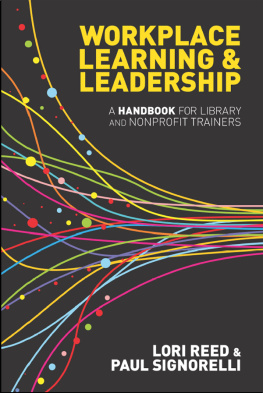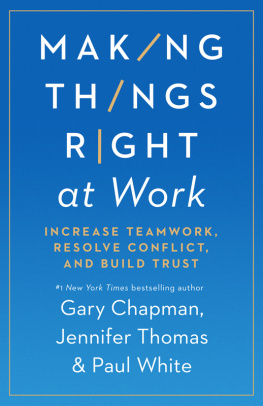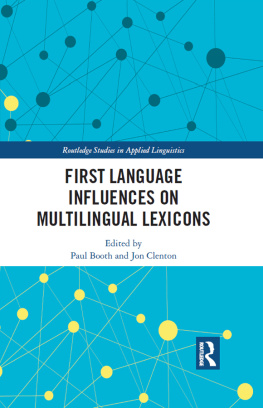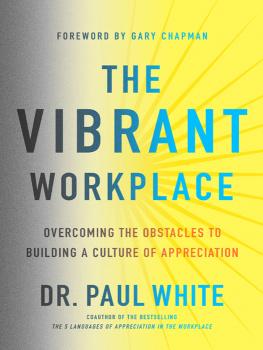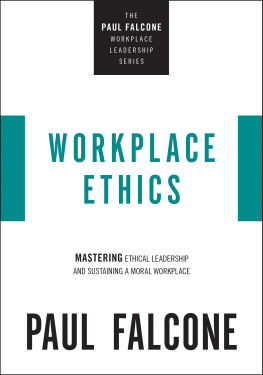PRAISE FOR THE 5 LANGUAGES OF APPRECIATION IN THE WORKPLACE
After twenty years of coaching leaders at all levels, and educating thousands of professional coaches around the world, I believe there are two universal things that ignite excellence within people: recognition of their uniqueness and acknowledgement that they matter. The 5 Languages of Appreciation in the Workplac e gives individuals, teams, and entire organizations an invaluable resource to do just that by making appreciation a foundational part of their culture.
AMY RUPPERT , Master Certified Coach; CEO, The Integreship Group; Past National President, the International Coaching Federation
Good leaders are known for their technical skills. Great leaders are known and remembered for how they make people feel. The 5 Languages of Appreciation in the Workplace is a must-have resource for any leader who wants to move the bar from being a good leader to a great leader.
KAREN ALBER , Founding Partner, The Integreship Group; Former Chief Information Officer, HJ Heinz
The 5 Languages of Appreciation in the Workplace has helped change the way managers around the world think about appreciation in the workplace. New research on the positive benefits to organizations when employees feel valued and appreciated for their contributions, generational differences, the special needs of remote employees, and peer-to-peer appreciation, are welcomed additions to a book that has already become a management classic. This book will be equally valuable to those who are at the start of their burgeoning management careers as it will be to seasoned managers by providing practical tips on how to engage the increasingly diverse workforce with relevant and relatable solutions.
PETER HART , President & CEO, Rideau, Inc.; Director, Advisory Board, Wharton Center for Human Resources, University of Pennsylvania
The 5 Languages of Appreciation in the Workplace has been a pivotal resource helping our employees and culture grow and mature. It is amazing to see how trust grows when care and appreciation are shown, as the correct language of appreciation for each employee is utilized. The insights found in this book are applicable to all generations and skill sets: introverts to extroverts, technical to relational abilitiesall have been able to apply these principles for meaningful growth.
EVAN WILSON , Chief Experience Officer, Meritrust Credit Union
There is a continual cry for authenticity in our workplaces and communities. This updated version of The 5 Languages of Appreciation in the Workplace brings a deeper understanding of HOW to be authentic in expressing individual value in a variety of circumstances. The business case for adopting The 5 Languages of Appreciation is stronger than ever, and this new edition provides the research foundation for the return on investment to organizations when they commit to building a strong, positive workplace culture, one coworker at a time!
DAN AGNE , Owner and Principal Consultant, The Agne Group; Director of Sales Effectiveness, The Brooks Group; Associate Pastor, Open Bible Christian Church, Dayton, Ohio
I greatly appreciate this second edition of The 5 Languages of Appreciation in the Workplace. White and Chapman have done an exceptional job of mixing statistics with stories and infusing research into relevancy. They give readers a nuanced approach to appreciating others at work that will enhance leaders and colleagues appreciation-literacy skills in being able to draw out the best in others at work (and home).
DAVID ZINGER , Founder, The Global Employee Experience & Engagement Network; Coauthor, People Artists: Drawing Out the Best in Others at Work
Drs. Chapman and Whites perspective about the reality of managers lives is spot on. Managers dont have capacity to give as much appreciation as the human spirit of their direct reports craves, in most cases. It takes a village to raise a child applies just as much to nurturing the fundamental needs of all human beings to be understood, valued, and appreciated. We all live, to some degree, in a village community and the principles in The 5 Languages of Appreciation in the Workplace make it much easier to do what most people intuitively want to give and receive.
TIM MYERS , Materials Lab Manager-Metallography, Honeywell, Inc.
Appreciation isnt just a manager issue; it is a coworker issue. It is an employee appreciating their leader issue, and a vendor to employee issuethe list goes on and on. In The 5 Languages of Appreciation in the Workplace , Drs. Chapman and White give us the vision to create a culture with everyone valuing and appreciating one another no matter the role they have in the organization.
TIFFANY SNIPES , Learning & Development Consultant, BJC Institute for Learning and Development
As a longtime user of the 5 Languages approach, I was excited to see the new material that has been added to highlight the proven financial benefits of appreciation, working with remote and virtual teams, appreciation across generations, and making a strong case for the overall increase in employee engagement. We continue to offer training on The 5 Languages of Appreciation in the Workplace as a valuable tool to our member companies. We have found that when team members learn what others actually value in regards to showing appreciation to each other, areas like team morale, cohesiveness, unity, and especially productivity increase, and drama decreases.
DAVE TIPPETT , Director, On Site Learning and Consulting, The Employers Association
Understanding The 5 Languages of Appreciation in the Workplace has been critical to our success in building a strong team and maintaining a positive culture. I aspire daily to demonstrate authentic appreciation toward my team members, peers, and leadership team. The focus on appreciation has increased employee engagement and strengthened our team dynamic.
MICHELLE SUTTER , Director of Sales, Holland America Line
Working with Dr. White brought to light the importance of building a sustainable appreciation culture. Through his workshops and personalized recognition tools, we are starting to see improved team dynamics and our appreciation communication shifting in the direction of tomorrow. While it didnt come naturally at first, we are learning to recognize each others language of appreciation and it is making a big difference.
JOANNA ZIARNIK , Research & Innovation, LOreal USA
2011, 2012, 2019 by GARY D. CHAPMAN AND PAUL E. WHITE
All rights reserved. No part of this book may be reproduced in any form without permission in writing from the publisher, except in the case of brief quotations embodied in critical articles or reviews.
Edited by Elizabeth Cody Newenhuyse
Interior design: Erik M. Peterson
Cover design: Faceout Studio
Gary Chapman photo: P.S. Photography
Paul White photo: Michael Bankston
Some names and details have been changed to protect the privacy of individuals.
The Library of Congress has cataloged the first printing of this book as follows:
Chapman, Gary D. The 5 languages of appreciation in the workplace : empowering organizations by encouraging people / Gary D. Chapman and Paul E. White.
p. cm.
Includes bibliographical references.
ISBN 978-0-8024-6176-6
1. Employee motivation. 2. Personnel management. I. White, Paul E.,
II. Title. III. Title: Five languages of appreciation in the workplace. HF5549.5.M63C438 2011





